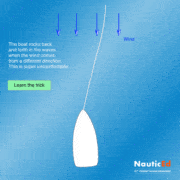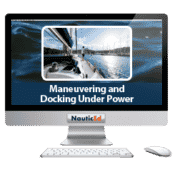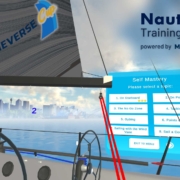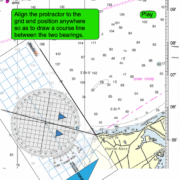SAILING BASICS: HOW TO USE A VHF RADIO
My brothers and I grew up in a sailing family. We had a 27-foot Catalina that we’d take out on the weekends any time the weather was nice and even when the weather wasn’t nice, we’d often still find ourselves on the boat, helping to scrub the decks and maintain the gear. On those days, we’d inevitably get bored, at which point the VHF radio would become a serious temptation. One day, when our dad was occupied somewhere on the bow, I grabbed the radio and said something silly. Before I could crack another joke, my dad was over top of me, grabbing the receiver out of my hand. I never knew he could move that fast! I learned the importance of VHF radio etiquette that day, and it’s a lesson I’ve never forgotten.
Your VHF radio is your best way to communicate with other boats on the water, with marinas, and with the coast guard, if necessary. VHF stands for “Very High Frequency.” It’s the standard form of communication on the water, is more reliable than cell phones, and it’s always being monitored. Learning to use it, however, is a little like learning a new language. You can’t just hop on and start talking.
Below are the basics, and you can learn VHF usage in-depth in NauticEd’s Bareboat Charter Clinic.
Always be listening
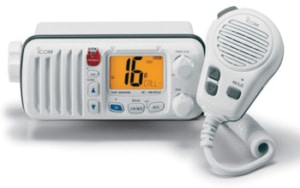
And note there are certain regulations that require you to keep a “Radio Watch” at all times. The rules state that in general, any vessel equipped with a VHF marine radiotelephone must maintain a watch on channel 16 (156.8MHz) whenever the radiotelephone is not being used to communicate.
Brush up on your VHF lingo
VHF communication has its own set of terms that have developed over the last century. These were originally brief, clear words and ideas that could be easily transmitted over telegraph. As vocal communication developed, these terms continued to develop and were used to keep communications brief and to avoid confusion and miscommunication. These terms are often called “procedure words,” or “prowords.” You can find exhaustive lists online, but here are a few basic ones that are good to know.
VHF Basic Features
Channel 16
Channel 16 is internationally recognized and designated as the calling and distress frequency channel.
Transmission Power
You should always use the lowest (1 watt) setting first. This reduces the broadcast distance and keeps overall interference down.
Squelch Control
The squelch control filters out static. With the unit on, turn the dial until the static sound just disappears. If you turn it too much the unit will filter out voice as well and you will not hear any transmissions.
DSC (Digital Selective Calling)
DSC is a button that instantly sends a digital distress alert to the Coast Guard. Using DSC transmits information about your vessel and location (if set-up properly), and should be transmitted if, in the opinion of the Master, the vessel or a person is in distress and requires immediate assistance.
VHF Procedure Words
Safety or Distress VHF Calls
There are three different levels of safety or distress calls, which boaters can use to let other boats in the area know of potential or real danger. Distress calls are initiated on Channel 16 (and a reason you always monitor it). If you hear or receive a distress call and cannot assist, immediately cease all transmission on Channel 16! Any vessel with knowledge of distress traffic who cannot assist is forbidden from transmitting on a distress channel (until you receive the “all clear”).
MAYDAY: This is an urgent and immediate distress call, made when a boat is in danger of sinking or there is a fire, man overboard, or medical emergency on board. Vessels that are close enough to help are required to do so. You should only make a mayday call if you are in serious or immediate danger. Below is the generally accepted procedure for a Channel 16 Mayday:
- If you have a VHF marine radio, tune it to channel 16. Unless you know you are outside VHF range of shore and ships, call on channel 16 first.
- A Mayday distress signal is first spoken three times, “MAYDAY, MAYDAY, MAYDAY”.
- The words “THIS IS”, spoken once.
- Name of the vessel in distress (spoken three times) and call sign or boat registration number, spoken once. *TIP: have this information written and nearby the VHF for anyone onboard calling a mayday. Seconds count in an emergency!
- Repeat “MAYDAY” and name of vessel, spoken once.
- Give position of the vessel by latitude or longitude or by bearing (true or magnetic, state which) and distance to a well-known landmark such as a navigational aid or small island, or in any terms which will assist a responding station in locating the vessel in distress. Include any information on vessel movement such as course, speed and destination.
- Nature of distress (sinking, fire etc.).
- Kind of assistance desired.
- The number of persons onboard.
- Any other information which might facilitate rescue, such as length or tonnage of the vessel, number of persons needing medical attention, color hull, cabin, masks, etc.
- The word “OVER”
Other Safety Calls
PAN: Boaters make this call when there is an urgent problem but it’s not life-threatening. You may hear this if a boater has lost engine power or is having navigational issues. The Coast Guard may follow up, but the boater is not necessarily requesting immediate help. As with Mayday, repeat PAN three times as in “PAN, PAN, PAN”.
SECURITY: (pronounced SAY-CURE-IT-TAY): A safety call, letting boaters in the area know about the movement of a large ship or other events. There is no danger, this is just for awareness. For example, in my local area, ferries will make a securite call when they’re going through a narrow pass between local islands or perhaps a navigational aid is drifting. Again, say it three times “SECURITY, SECURITY, SECURITY”.
Other Common VHF Terms
A handful of useful VHF terms that are commonly used to keep conversations direct and brief, especially if you’re using channel 16.
THIS IS… The main way to identify yourself, using the name of your boat. You use this after identifying the party you are calling (more on that in a moment).
OVER: Used when you’ve finished speaking and are expecting a reply.
ROGER: A quick way to say you understand what someone else is saying. “Roger” comes from the morse code days when “R” indicated “received”, and is sometimes understood as “Received Order Given, Expect Results.”
WILCO: “Wilco” means simply “will comply”. It’s often used with Roger as in “Roger Wilco” (message received, will comply).
REPLY: “Reply” is used to change channels, for example changing to a non-emergency or non-commercial channel if using channel 16. Usage is simply Reply + Channel#, as in “Reply 68” (i.e., reply on channel 68).
OUT: Used when you’ve finished speaking and a reply is not necessary.
*Pro tip: you should never use the phrase “over and out,” since the two words mean two opposite things!
SAY AGAIN: Used when you need the speaker to repeat a portion or all of their previous transmission. This term is often used with:
ALL BEFORE…: Everything before whichever word you understood first.
ALL AFTER…: Everything after the word you last understood.
There are a couple of other rules to remember when it comes to lingo. You’ll want to learn the NATO phonetic alphabet. This is the standard way to clearly communicate single letters. When communicating numbers, you’ll want to communicate each number individually. For example, for the number 112, you would say, “One-one-two.”
“Heave to” with a little VHF language humor…
When using a VHF radio, three times is the charm
Whenever you use your radio to speak to another vessel, you should be addressing a particular party. Channel 16 not a broadcasting tool (unless you’re in distress, of course), and if you use channel 16 you must, must be brief!
There is a calling procedure that helps everyone listening to be clear on who is speaking, who is being addressed, and who needs to respond. Standard practice is to speak the name of the vessel (or marina) you’re addressing three times, then say “this is,” then the name of your boat. For example:
Lady Grey, Lady Grey, Lady Grey,
This is Time Out
Over
You would then wait for the other boat to respond. When responding to a message, you don’t need to say the vessel’s name three times again. So, for example, if the other vessel was to respond, they would say something like:
Time Out
This is Lady Grey
Over
IF using channel 16, then you should respond and move the conversation to another channel, especially if it’s not an emergency. Remember that the emergency and commercial channels, like channel 16, are not for casual conversation.
Time Out
This is Lady Grey
Reply 68 (or whichever other non-commercial channel you want to use)
Over
Knowing VHF etiquette helps keep everyone safe and helps you have good, helpful communication with other vessels. I can tell you from experience, there is nothing more embarrassing than being told off by the coast guard because you’re misusing your radio. When you’re out on the water, these simple rules will help you listen carefully and speak confidently!
Learn all about using VHF marine radios in our Bareboat Charter Clinic course – including DSC (Digital Selective Calling), effective distances, phonetic alphabet, and more!

